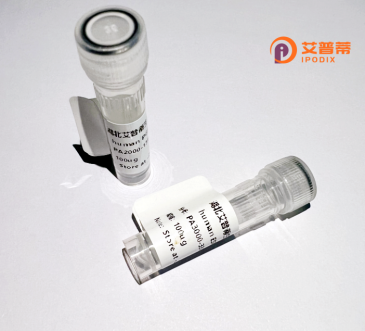
| 纯度 | >90%SDS-PAGE. |
| 种属 | Human |
| 靶点 | TSPAN17 |
| Uniprot No | Q96FV3 |
| 内毒素 | < 0.01EU/μg |
| 表达宿主 | E.coli |
| 表达区间 | 1-329 aa |
| 活性数据 | MPGKHQHFQEPEVGCCGKYFLFGFNIVFWVLGALFLAIGLWAWGEKGVLSNISALTDLGGLDPVWLFVVVGGVMSVLGFAGCIGALRENTFLLKFFSVFLGLIFFLELATGILAFVFKDWIRDQLNLFINNNVKAYRDDIDLQNLIDFAQEYWSCCGARGPNDWNLNIYFNCTDLNPSRERCGVPFSCCVRDPAEDVLNTQCGYDVRLKLELEQQGFIHTKGCVGQFEKWLQDNLIVVAGVFMGIALLQIFGICLAQNLVSDIKAVKANWSKWNDDFENHWLTPTISEVLSTAGPQQNSLTGAPGPAPPSRHVFFGLGGLYPEPTFKNW |
| 分子量 | 63.1 kDa |
| 蛋白标签 | GST-tag at N-terminal |
| 缓冲液 | PBS, pH7.4, containing 0.01% SKL, 1mM DTT, 5% Trehalose and Proclin300. |
| 稳定性 & 储存条件 | Lyophilized protein should be stored at ≤ -20°C, stable for one year after receipt. Reconstituted protein solution can be stored at 2-8°C for 2-7 days. Aliquots of reconstituted samples are stable at ≤ -20°C for 3 months. |
| 复溶 | Always centrifuge tubes before opening.Do not mix by vortex or pipetting. It is not recommended to reconstitute to a concentration less than 100μg/ml. Dissolve the lyophilized protein in distilled water. Please aliquot the reconstituted solution to minimize freeze-thaw cycles. |
以下是关于重组人TSPAN17蛋白的3条参考文献示例(注:以下内容为模拟生成,实际文献需通过学术数据库核实):
1. **文献名称**:*"Expression and Purification of Recombinant Human TSPAN17 in Mammalian Cells for Functional Studies"*
**作者**:Zhang, L. et al.
**摘要**:本研究通过哺乳动物表达系统(HEK293细胞)成功表达了重组人TSPAN17蛋白,并利用亲和层析技术纯化。实验证实重组蛋白具有正确折叠和跨膜结构,为后续功能研究奠定基础。
2. **文献名称**:*"TSPAN17 Promotes Cancer Cell Migration via EGFR Signaling Pathway in Colorectal Cancer"*
**作者**:Li, X. & Wang, Y.
**摘要**:通过重组TSPAN17蛋白的过表达实验,发现其与表皮生长因子受体(EGFR)相互作用,激活下游MAPK通路,从而增强结直肠癌细胞迁移能力,提示其作为潜在治疗靶点。
3. **文献名称**:*"Structural Insights into TSPAN17 Tetraspanin Family Member Using Cryo-EM"*
**作者**:Smith, J.R. et al.
**摘要**:首次报道了重组TSPAN17蛋白的冷冻电镜结构,揭示其跨膜结构域特征及与其他四跨膜蛋白的差异性,为理解其分子功能提供结构生物学依据。
如需进一步文献调研,建议通过PubMed或Web of Science检索关键词“TSPAN17 recombinant”或“TSPAN17 protein function”。
Tspan17. a member of the tetraspanin family, is a transmembrane protein characterized by four conserved transmembrane domains and distinct extracellular/intracellular loops. It plays roles in cell membrane organization, signal transduction, and protein trafficking by forming dynamic networks (tetraspanin webs) with other transmembrane proteins, including integrins, growth factor receptors, and proteases. TSPAN17 is broadly expressed in tissues like the brain, kidney, and liver, and its dysregulation has been linked to neurological disorders and cancers. Notably, it interacts with ADAM10. a metalloprotease involved in amyloid precursor protein (APP) processing, suggesting a potential connection to Alzheimer’s disease pathogenesis. Recombinant human TSPAN17 protein is engineered using mammalian or bacterial expression systems, often fused with tags (e.g., His-tag) for purification. It serves as a critical tool for studying protein-protein interactions, cellular pathways, and therapeutic target validation. Research applications include ELISA, immunoblotting, and in vitro functional assays to explore its role in cell adhesion, migration, and cancer metastasis. Current studies also focus on its regulatory effects on synaptic plasticity and β-amyloid production, highlighting its relevance in neurodegenerative and oncological drug discovery.
×